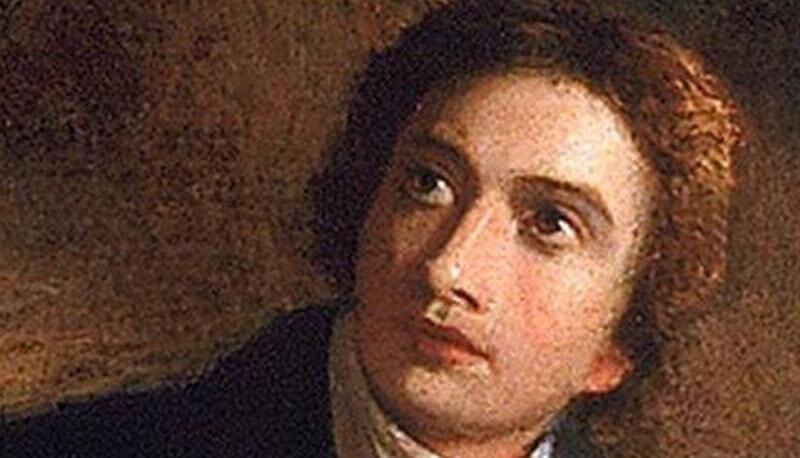Concetti Chiave
- John Keats, born in London in 1795, faced early hardships, losing both parents and ending formal education prematurely.
- Initially apprenticed as a surgeon, Keats shifted to poetry in 1816, inspired by Chapman's translation of Homer and the literary circles of Leigh Hunt.
- Keats's first major poem, Endymion, faced harsh criticism, impacting his health, yet he continued to write with urgency.
- Between 1819 and 1820, Keats composed his most acclaimed works, including Hyperion, La Belle Dame sans Merci, and several famous odes.
- Despite deteriorating health, Keats's letters from 1818-19 provide insight into his poetic development and are considered a spiritual autobiography.
John Keats was born in London in 1795. He began his studies at a private school in Enfield, and here was introduced to the study of literature. Unfortunately he soon lost both his parents and was placed in the care of a strict guardian, who took him out of Enfield school, thus prematurely ending his formal education.
Scelta della poesia e influenze artistiche
At the age of 15 he was apprenticed to a surgeon and spent the next four years following medical studies, but his inclination were literary, and he continued to read passionately. In 1816 he abandoned surgery and chose poetry as a profession. Later in the same year the reading of Champman’s translation of Homer thrilled him and prompted his wounderful early sonnet On First Looking into Champman’s Homer. He was introduced to Leigh Hunt, the famous radical journalist and poet, and through Hunt Keats came to know writers and artists, whose devotion to art influenced him. Even if the family tendency to consumption had become manifest in him, Keats went with a friend on a walking tour through the highlands, but the hardships further affected his health.
His first long and serious poem, Endymion, which contains the famous statement “A thing of beauty is a joy for ever” was published in April 1818, and was violently attacked by the two leading journals of the day. These Tory journals brutally assailed the young poet not only for his literary shortcomings, but mainly for his friendship with the radical Leigh Hunt. John Keats bore the attack with apparent serenity, but there can be doubt that his health was affected to some degree.

Amore e urgenza creativa
Around this time he fell passionately in love with Fanny Brawne and they were engaged for a time, but financial difficulties and Keats’s failing health precluded marriage.
Keats continued to write poetry with almost feverish urgency, which indicated that he was aware that only a very short time was left to him to find a place in English literature, and between 1819 and 1820 he produced the best of his poetic creation: Hyperion, an unfinished poem retelling the myth of the war between the Greek gods and the Titans; La Belle Dame sans Merci; The Eve of St Agnes; Lamia; the Odes: To Psyche, To Nightingale, On a Grecian Urn, To Autumn, On Melancholy. Most of his best poems appeared in 1820 in the greatest single volume of poetry wich was to be finished in the 19th century.

Lettere e ultimi giorni
But Keats did not only verse. In the same period 1818-19 he wrote numerous letters, which contain precious information on his development as a poet and the working genius, and can be considered a remarkable spiritual autobiography.
Early in 1820 John Keatscoughed up blood and understood its meaning at once: "that drop of blood is my death warrant”. He travelled to Italy in the hope of some alleviation with a warmer climate, and reached Rome where he died three months later, February 1821. His remains were buried in the English Cemetery in Rome. On his gravestone is carved the following self-written epitaph: “Here lies one whose name was writ in water”.
Domande da interrogazione
- ¿Cuál fue el impacto de la educación temprana de John Keats en su carrera literaria?
- ¿Cómo influyó Leigh Hunt en la vida de John Keats?
- ¿Qué efecto tuvo la salud de Keats en su producción poética?
- ¿Qué importancia tienen las cartas de John Keats en su legado literario?
- ¿Cuál fue la reacción de Keats al deterioro de su salud y cómo terminó su vida?
La educación temprana de Keats en Enfield lo introdujo a la literatura, pero su educación formal terminó prematuramente cuando su tutor lo sacó de la escuela. A pesar de esto, continuó leyendo apasionadamente y finalmente eligió la poesía como profesión.
Leigh Hunt, un periodista y poeta radical, introdujo a Keats a un círculo de escritores y artistas que influyeron en su devoción por el arte, a pesar de que su amistad con Hunt también atrajo críticas de los principales diarios conservadores de la época.
La salud de Keats, afectada por la tendencia familiar a la tuberculosis, lo impulsó a escribir con urgencia febril, consciente de que tenía poco tiempo para dejar su huella en la literatura inglesa, produciendo sus mejores obras entre 1819 y 1820.
Las cartas de Keats, escritas entre 1818 y 1819, son valiosas por la información que proporcionan sobre su desarrollo como poeta y su genio creativo, y se consideran una notable autobiografía espiritual.
Al toser sangre a principios de 1820, Keats comprendió que su salud estaba gravemente comprometida. Viajó a Italia con la esperanza de mejorar en un clima más cálido, pero murió en Roma en febrero de 1821, siendo enterrado en el Cementerio Inglés de Roma.







 Accedi a tutti gli appunti
Accedi a tutti gli appunti
 Tutor AI: studia meglio e in meno tempo
Tutor AI: studia meglio e in meno tempo